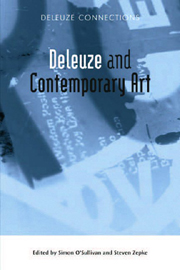Book contents
- Frontmatter
- Contents
- Acknowledgements
- List of Illustrations
- Introduction: Deleuze and Guattari and Contemporary Art
- POLITICS
- THE AESTHETIC PARADIGM
- 5 Capitalism and Schizophrenia and Consensus: Of Relational Aesthetics
- 6 The Practice and Anti-Dialectical Thought of an ‘Anartist’
- 7 Ethologies of Software Art: What Can a Digital Body of Code Do?
- 8 Fractal Philosophy (And the Small Matter of Learning How to Listen): Attunement as the Task of Art
- SCENES AND ENCOUNTERS
- TECHNOLOGIES
- Notes on Contributors
- Index
7 - Ethologies of Software Art: What Can a Digital Body of Code Do?
from THE AESTHETIC PARADIGM
Published online by Cambridge University Press: 12 September 2012
- Frontmatter
- Contents
- Acknowledgements
- List of Illustrations
- Introduction: Deleuze and Guattari and Contemporary Art
- POLITICS
- THE AESTHETIC PARADIGM
- 5 Capitalism and Schizophrenia and Consensus: Of Relational Aesthetics
- 6 The Practice and Anti-Dialectical Thought of an ‘Anartist’
- 7 Ethologies of Software Art: What Can a Digital Body of Code Do?
- 8 Fractal Philosophy (And the Small Matter of Learning How to Listen): Attunement as the Task of Art
- SCENES AND ENCOUNTERS
- TECHNOLOGIES
- Notes on Contributors
- Index
Summary
Art of the Imperceptible
In a Deleuzo-Guattarian sense, we can appreciate the idea of software art as the art of the imperceptible. Instead of representational visual identities, a politics of the art of the imperceptible can be elaborated in terms of affects, sensations, relations and forces (see Grosz 2008). Such notions are primarily nonhuman and exceed the modes of organisation and recognition of the human being, whilst addressing themselves to the element of becoming within the latter. Such notions, which involve both the incorporeal (the ephemeral nature of the event as a temporal unfolding instead of a stable spatial identity) and the material (as an intensive differentiation that stems from the virtual principle of the creativity of matter), incorporate ‘the imperceptible’ as a futurity that escapes recognition. In terms of software, this reference to nonhuman forces and to imperceptibility is relevant on at least two levels. Software is not (solely) visual and representational, but works through a logic of translation. But what is translated (or transposed) is not content, but intensities, information that individuates and in-forms agency; software is a translation between the (potentially) visual interface, the source code and the machinic processes at the core of any computer. Secondly, software art is often not even recognised as ‘art’ but is defined more by the difficulty of pinning it down as a social and cultural practice.
- Type
- Chapter
- Information
- Deleuze and Contemporary Art , pp. 116 - 132Publisher: Edinburgh University PressPrint publication year: 2010



